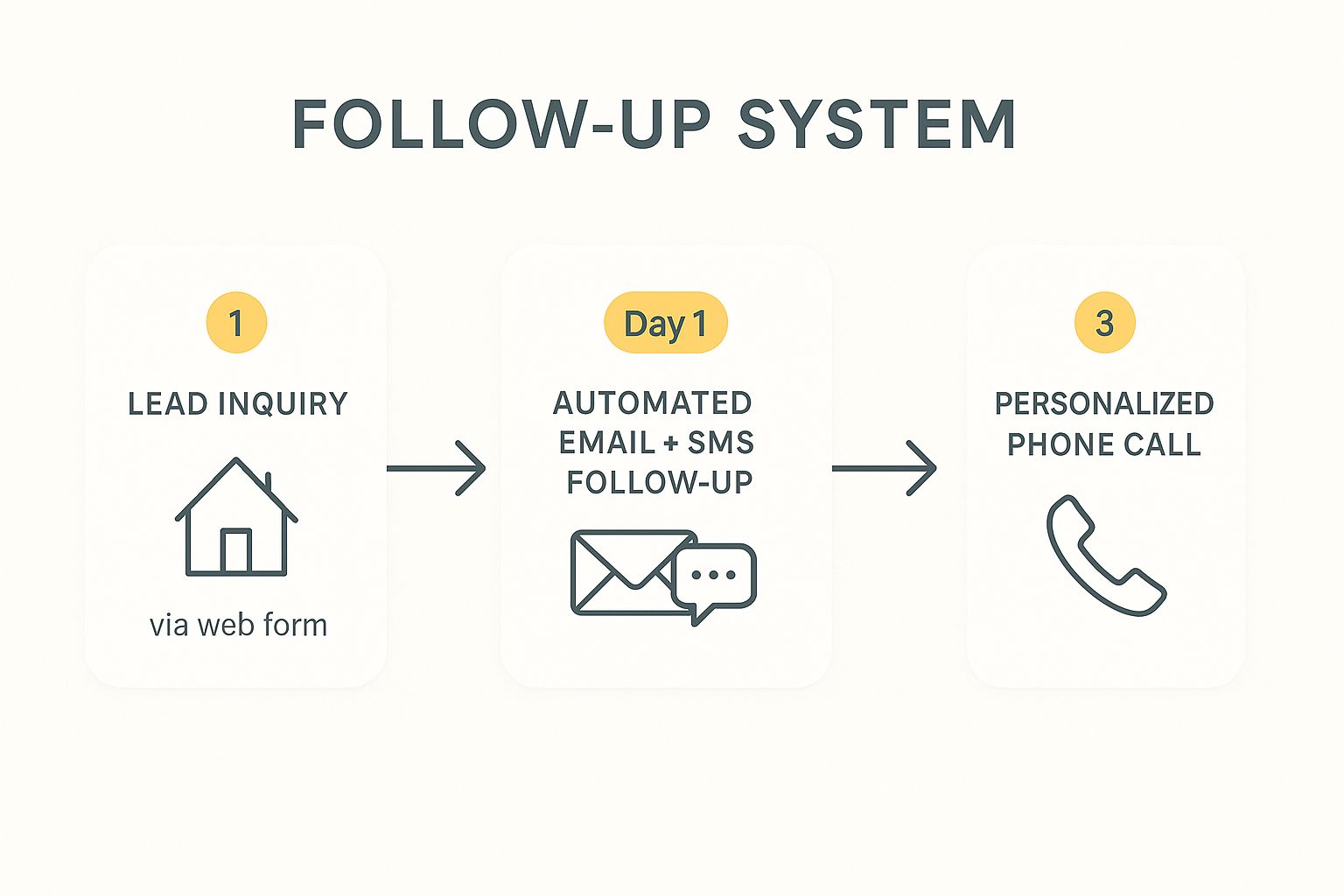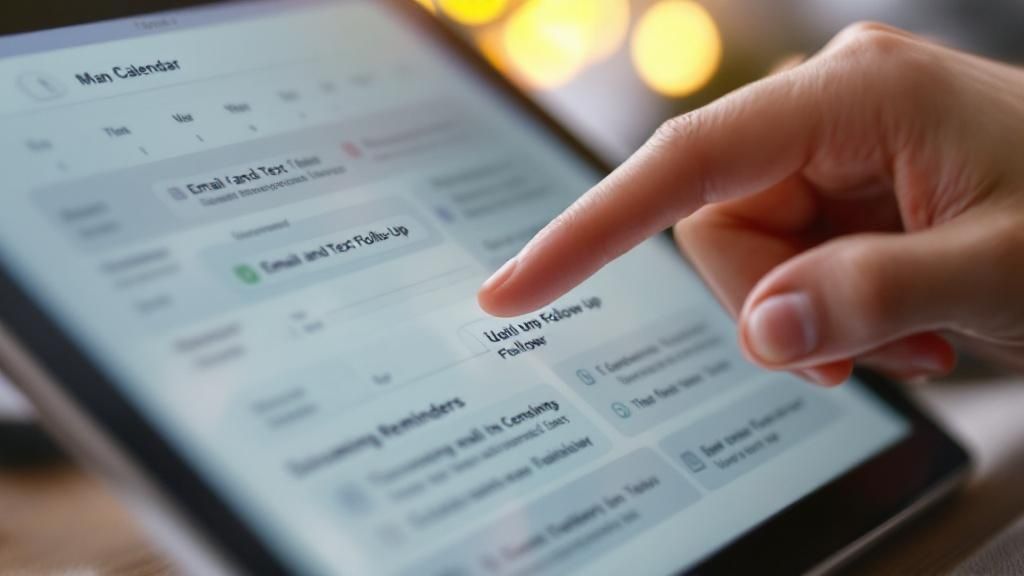Let's be honest, a great real estate follow-up system comes down to three things: smart segmentation, practical automation, and a genuine, personal touch. When deals fall through the cracks, it’s rarely because of a lack of interest. More often than not, it's because the follow-up felt generic, impersonal, or just didn't happen at all.
Why Your Follow-Up Fails (And How to Actually Fix It)

Time and again, I’ve seen lost deals trace back to one single culprit: a broken or non-existent follow-up process. In a market this competitive, a simple "just checking in" email just won't cut it anymore. That one-size-fits-all approach feels lazy and makes potential clients feel like another number in your CRM.
This is where so many agents stumble. You might have a great list of leads from an open home or a flood of online enquiries, but without a structured plan to nurture them, you're just hoping for the best. The result? Those promising leads go cold, and potential commission vanishes into thin air.
The Real Cost of Poor Follow-Up
Picture this all-too-common scenario: you connect with a dozen promising people at an open home. You collect their details, fire off a generic "thank you" email the next day, and then… crickets. A week passes, and you suddenly remember a couple who seemed really keen. But by the time you finally call, they've already signed with another agent who was on the ball.
This isn't just bad luck; it's a systemic failure. When you rely on memory and chance, you're using two of the most unreliable business partners out there. Every single lead that slips through the cracks represents thousands of dollars in lost potential income.
Effective follow-up isn't just about being persistent; it’s about being relevant and timely. The goal is to build a system that delivers the right message to the right person at exactly the right moment. This is how you build trust and show your value long before a contract is even on the table.
A Harvard Business Review study found that getting back to a lead within the first hour makes a successful contract seven times more likely compared to waiting just two hours. It just goes to show how critical speed and structure really are.
Audit Your Current Approach
Before you can fix the problem, you need to know exactly where the leaks are. Start by asking yourself a few tough questions about what you're doing right now:
- Where do my leads come from? (e.g., website, portals, open homes, referrals)
- What happens the moment a new lead comes in? Is the response manual or automated? Is it instant?
- How do I decide who to follow up with next? Is it a gut feeling, or do I have a structured priority list?
- What's my communication rhythm? Is there a clear plan for Day 1, Day 3, Day 7, and beyond for different types of leads?
Your answers will shine a light on the gaps in your strategy. Maybe you're great at that initial contact but have zero long-term nurture plan. Or perhaps you're treating a hot lead from your website the same way you treat a cold lead from six months ago. A robust system plugs these leaks.
Without a solid process, even the sharpest agent can let opportunities slide, which is where a dedicated real estate answering service can be a lifesaver, ensuring every initial enquiry is captured.
The Core Components of a High-Performing Follow Up System
To build a system that genuinely works, you need to shift from being reactive to proactive. A truly effective strategy is built on three foundational pillars that work in harmony to create a seamless experience for your clients.
Here’s a simple breakdown of what that looks like in practice.
| Pillar | Purpose | Key Activities |
|---|---|---|
| Smart Segmentation | To group leads by their source, behaviour, and readiness to transact for more targeted messaging. | Categorising leads as hot, warm, or cold. Tagging them by source (e.g., Open Home, Website Enquiry). |
| Practical Automation | To manage repetitive, time-sensitive tasks, making sure no lead gets missed and every communication is consistent. | Setting up automated welcome emails, task reminders for calls, and drip campaigns for long-term nurturing. |
| Genuine Personalisation | To make every interaction feel one-on-one, building rapport and showing you're genuinely invested. | Referencing previous chats, mentioning specific properties they liked, and sharing relevant market data. |
These pillars aren't just theory; they deliver real-world results. According to the 2024 State of Real Estate Report, which surveyed over 130,000 Australians, agents with systematic follow-ups not only saw better communication and more sales but also enjoyed referral rates up to 20% higher.
It's clear proof that a strong real estate follow up system is one of the best investments you can make in your business, directly building client trust and securing future income.
Designing Follow-Up Blueprints for Every Lead
Let's be honest, a one-size-fits-all approach to following up with leads is a fast track to missed opportunities. It just doesn't work. The real magic in a powerful real estate follow-up system comes from creating specific blueprints that match where the lead came from, what they want, and where they are in their property journey.
Think about it: a hot enquiry from your website needs a completely different touch than a past client you're hoping to get a referral from. So, let's move from theory to action by designing distinct, practical sequences for every type of lead you'll encounter. This isn't about setting up robotic, impersonal automation. It's about crafting communication plans across multiple channels that feel personal and actually add value.
The Hot Lead Sprint
When a new lead pops up from a property portal or your website, you need to act fast. Speed and intensity are everything. These people are actively searching and, you can bet, are talking to other agents. Your goal is to make a strong, immediate impression and lock in an appointment before your competition even has a chance.
I've found a 10-day sprint works wonders for these high-intent leads. It's designed to be assertive without crossing the line into annoying, using a mix of communication methods to give you the best shot at making contact.
Here’s what a blueprint for a hot lead could look like:
- Day 1 (Within 5 minutes): An automated SMS and email go out instantly. The SMS confirms you got their enquiry and asks a simple question, like "When's a good time for a quick chat about 123 Smith Street?". The email can provide a bit more property info and introduce you.
- Day 1 (Within 1 hour): You make the first phone call. No answer? Leave a brief, friendly voicemail. Don't ramble.
- Day 2: Send a personal video message via text. A quick, 30-second clip of you saying, "Hi [Name], just following up on your enquiry…" adds a seriously powerful human touch.
- Day 4: Follow up with an email containing similar properties or a local market update for their suburb of interest.
- Day 7: Time for another phone call attempt, but try a different time of day.
- Day 10: Send a final "break-up" style email. A polite message saying you're closing their file for now but are here to help if they need anything often gets a response.
This infographic gives you a snapshot of how to handle those critical first few days with a new online lead.

As you can see, the key is hitting them with an immediate, multi-channel response to grab their attention while their interest is at its absolute peak.
The Long-Term Nurture Sequence
Not every lead is ready to sign on the dotted line today. Think about those open house attendees who are "just looking," or even your past clients. The goal here isn't a quick appointment; it's about staying top-of-mind over months, or sometimes even years. Your blueprint needs to focus on consistently providing genuine value.
A study by a real estate software company found that the average lead takes anywhere from 6 to 24 months to move toward a transaction. A single follow-up attempt simply isn't enough.
For these leads, a 12-month value-add nurture sequence is the way to go. This is your slow-drip campaign that cements you as the go-to local market expert.
Sample Long-Term Nurture Touches:
- Quarterly: Send a detailed local market report email that breaks down recent sales and trends in their suburb.
- Bi-Annually: Offer a complimentary, no-obligation property appraisal.
- Anniversary: For past clients, a simple "home-iversary" card or email celebrating one year in their new home goes a long way.
- Ad-Hoc: Share genuinely useful content, like "Tips for Boosting Your Home's Kerb Appeal in Autumn" or "Local Council Development Updates."
This consistent, low-pressure contact builds incredible trust, making sure you're the first agent they call when they're finally ready to make their move. This long-game approach is crucial, especially in a market poised for major growth. The Australian real estate market, currently valued around USD 206.8 billion, is tipped to hit USD 305.8 billion by 2033. This growth is being fuelled in part by technology, with systems now helping agents share updates on things like sustainability features—something more and more Aussie buyers care about. You can read more about these market projections for Australia on imarcgroup.com.
Re-Engaging Cold Leads
So, what about all those leads in your database who've gone completely radio silent? A re-engagement campaign can be surprisingly effective at waking them up. This blueprint is designed to jolt them into a response and help you re-qualify their interest.
Try a simple, three-step "Pattern Interrupt" campaign:
- Email 1: Send a super direct email with the subject line "Still looking for a home in [Suburb]?" The body can be a single sentence: "Hi [Name], are you still interested in buying/selling in the area?"
- SMS: Two days later, send a text: "Hi [Name], just sent you a quick email. Let me know if you're still in the market. [Your Name]."
- Email 2: A week later, use the "Closing the Loop" email. "Hi [Name], since I haven't heard back, I'll assume your plans have changed. I'm taking you off my active search list for now, but feel free to reach out anytime. All the best."
This direct approach respects their time and often gets a quick "Yes, still looking!" or "No, thanks," which lets you clean up your database and focus your energy on people who are actually active. Taking the time to create these specific blueprints is the single most practical step you can take to turn your real estate follow-up system from a chore into your most powerful conversion tool.
Choosing the Right Tools to Automate Your Follow-Up

Let's be honest, an intelligent follow-up strategy is only as powerful as the tech that brings it to life. Without the right tools, even the most carefully crafted plans are just ideas on paper. The good news? You don’t need an enterprise-level budget to build a high-performing tech stack for your real estate follow-up system.
The goal here is to pick software that actually fits your business goals, your tech-savviness, and your wallet. Instead of just listing off features, let's look at how specific tools solve real-world problems for agents on the ground. This is about finding software that can automatically send a “home-iversary” message to past clients or trigger a local market report the moment a lead revisits a listing on your site.
The Foundation: Your Real Estate CRM
Your Customer Relationship Management (CRM) system is the command centre for your entire follow-up operation. It's so much more than a digital address book; it’s where you store, track, segment, and manage every single interaction with every lead and client. A good real estate CRM is what separates organised chaos from streamlined success.
When you’re looking at CRMs, dig deeper than the basic contact management stuff. The best platforms will offer:
- Lead Scoring: This is a game-changer. It automatically prioritises your hot leads based on their behaviour—like how many times they've viewed a property or opened your emails. It helps you focus your energy where it counts most.
- Workflow Automation: This is the engine that runs those multi-step follow-up plans we talked about. For example, when a new lead is tagged "Open House Attendee," it can kick off a specific email and SMS sequence automatically. No manual work needed.
- Integration Capabilities: Your CRM needs to play nice with the other tools you use, like your website, email marketing platform, and even your calendar.
A solid CRM centralises all your lead data, giving you a complete 360-degree view of every relationship. Think of it as the single source of truth that powers every other part of your follow-up machine.
Specialised Tools for Specific Jobs
While an all-in-one CRM is essential, you can often get better results by adding specialised tools designed to do one thing exceptionally well. This approach lets you build a custom system that's perfectly suited to your specific needs.
Automated Drip Campaign Software
This is crucial for long-term nurturing. Sure, many CRMs have this built-in, but dedicated platforms often offer more advanced analytics and A/B testing. These tools let you "set and forget" your 12-month value-add sequences, making sure no past client or long-term prospect ever falls through the cracks.
Intelligent Call Management
Phone calls are vital for building genuine connections, but managing them can be a massive time-suck. Answering every single call isn't always practical, and sifting through voicemails is just inefficient. Modern tools are built to filter the noise and help you prioritise what matters. For instance, to keep all your communication organised, you might look into how call management software can improve your workflow by sorting messages and ensuring you only focus on the most important follow-up calls.
It’s a well-known sales insight that it can take up to five meaningful contacts to convert a lead. If you’re relying solely on manual methods, you'll struggle to ever achieve that kind of consistency. Automation is the key to scaling your efforts without burning out.
Making the Right Choice for Your Agency
Picking your tech stack can feel overwhelming, but it really boils down to a few key things. Before you pull the trigger on any software, run it through this simple checklist to make sure it’s the right fit.
| Evaluation Criteria | What to Look For |
|---|---|
| User-Friendliness | Is the interface intuitive? You shouldn't need a computer science degree to set up a basic workflow. Look for a clean dashboard and clear navigation. |
| Scalability | Will this tool grow with you? A system that works for 50 leads should also be able to handle 500 without breaking a sweat. |
| Cost vs. Value | Don't just look at the price tag. Think about the time it will save you. If a $100/month tool saves you 10 hours of admin, it's paying for itself. |
| Support and Training | What happens when you get stuck? Look for providers with strong customer support, detailed help guides, and video tutorials. Good support is non-negotiable. |
Ultimately, the best real estate follow-up system is one you’ll actually use. Start with a solid CRM as your foundation, then layer on specialised tools that solve your biggest communication headaches. By making smart, strategic technology choices, you can automate the mundane tasks and free yourself up to do what you do best: building relationships and closing deals.
Of course! Here is the rewritten section, crafted to sound like it was written by an experienced human expert, following all your specified requirements.
Crafting Messages That Actually Get a Response
You can have the smartest automation and the most perfectly timed follow-up system in the world, but if your messages are a snooze-fest, none of it matters. This is where we ditch the tired, old "just checking in" routine and start writing messages that genuinely make someone want to reply. It all comes down to understanding the simple psychology of what makes a person stop what they're doing, read your message, and actually respond.
The real art here is to provide value, spark a little curiosity, and make the person on the other end feel like you actually see them as an individual. Every single email, SMS, and even your call scripts need a clear purpose. Are you trying to get feedback? Offer them a piece of exclusive info? Or just build a bit of a relationship? Forget the generic templates everyone else is using; we’re talking about flexible frameworks you can tweak for any real-world situation.
Moving Beyond the Generic "Check-In"
Honestly, the biggest mistake I see agents make is making their follow-up all about them. Lines like "Just wanted to follow up" or "Circling back on our chat" are instant turn-offs. They basically scream, "I want something from you." To get a reply, you’ve got to flip the script and make it all about them.
This means every time you reach out, you should be giving them something of value, even if it's small. Instead of begging for a moment of their time, offer them a helpful resource. Instead of asking if they're "still interested," share a new insight that helps their property search. It’s a simple shift from taking to giving, but it’s the foundation of a message that’s worth replying to.
Think about it this way: after a property appraisal, don't just send a generic thank-you note. A much better approach is an email with a subject like, "A few extra thoughts on 123 Main Street". In the body, you could include a link to a recent, comparable sale in their area that wasn't in the initial report. This shows you're proactively thinking about them and providing value, which opens the door for a natural conversation.
Here’s a little psychological tip: people are wired for reciprocity. When you offer genuine value upfront with no strings attached, people feel a natural urge to give something back—often, that's as simple as hitting 'reply'.
Real-World Scenarios and Message Frameworks
Let's get practical and break down how this works in a few common situations. The goal isn't to give you scripts to copy and paste, but to show you the thinking behind them so you can adapt the strategy to any lead.
Scenario 1: The Open House Attendee
- Weak Message: "Hi Alex, thanks for coming to the open house on Saturday. Let me know if you have any questions." (Yawn…)
- Strong Message (SMS): "Hi Alex, it's Ben. Great to meet you at 45 Elm St. I noticed you spent some time in the kitchen. We just got a list of the specific appliance upgrades the owner made. Want me to send it over?"
See the difference? The strong message is personal, specific, and offers exclusive information. It gives them a compelling reason to reply with a simple "yes."
Scenario 2: The Long-Term Nurture
- Weak Message: "Hi Sarah, just checking in to see if you're still thinking about selling." (So needy!)
- Strong Message (Email): "Hi Sarah, a property just sold down the street from you that might impact your home's value. It had a few unique features that buyers loved. Thought you might find the final sale price interesting."
This message piques their curiosity and positions you as a local expert who's looking out for their interests, not just chasing their listing.
Tone, Timing, and Your Call-to-Action
The last few pieces of the puzzle are your tone, timing, and what you’re actually asking them to do.
- Tone: Keep it conversational yet professional. A good trick is to read your messages out loud. If they sound stiff or like a robot wrote them, it's time for a rewrite.
- Timing: Match the medium to the message. An SMS is perfect for a quick, time-sensitive follow-up. An email is better when you need to share more detailed info, like a market report.
- Call-to-Action (CTA): Make your CTA as easy as possible. Instead of asking, "Can we schedule a 30-minute call?", try something like, "Is that something you'd find helpful?". A simple yes/no question is far easier to answer than a request that involves checking calendars.
This level of detail is more critical than ever. The Australian real estate services industry is booming, with revenues around $30.9 billion, and it's only set to grow. Government migration policies are aiming for 185,000 permanent places, which will just pour more fuel on housing demand. You can dig into more data about the Australian real estate industry from IBISWorld.
This means a flood of new leads is coming, and your ability to manage them with an effective follow-up system will be what separates you from the pack. By crafting messages that cut through the noise, you build the kind of rapport that turns a simple enquiry into a closed deal.
Measuring and Optimising Your System Performance

Here's a hard truth: a powerful real estate follow up system isn't something you can 'set and forget'. Think of it as a high-performance engine that needs regular tuning to keep it firing on all cylinders. Launching your automated sequences is really just the starting line. The real path to a better ROI comes from methodically tracking what’s working, figuring out what isn’t, and making smart, data-driven tweaks.
If you aren't tracking performance, you’re basically flying blind. You might feel like you're busy, but you have no real idea if your efforts are actually turning into appointments and, ultimately, commissions. By homing in on a few core metrics, you can stop guessing and start refining your system with a clear, actionable strategy.
It's this continuous loop of measuring, interpreting, and tweaking that separates a decent follow-up system from a truly great one. It’s what allows you to polish your workflows, making sure every message you send has the best possible chance of getting a result.
Key Metrics That Actually Matter
It’s easy to drown in data, so let’s cut through the noise. Forget the vanity metrics and zero in on the numbers that directly impact your bottom line. These three will give you a crystal-clear picture of your system's health.
- Open Rates: This tells you one thing: how good are your subject lines? Low open rates are a dead giveaway that your initial pitch isn't compelling enough to even earn a click.
- Response Rates: This is arguably the most crucial metric of them all. It shows you how many people are actually engaging with you. A high open rate with a rock-bottom response rate means your message was seen, but it completely failed to start a conversation.
- Lead-to-Appointment Conversion Rate: This is the ultimate proof of success. It tracks how many leads from a campaign actually turn into a scheduled meeting or call, directly tying your follow-up efforts to real business outcomes.
Tracking these numbers inside your CRM or communication platform is your feedback loop. A centralised dashboard gives you that command centre view, showing you not just overall response rates, but which channels are doing the heavy lifting. For instance, if your email responses are consistently poor but SMS replies are strong, that’s a clear signal to shift your focus.
Interpreting the Data and Taking Action
Once you've got the numbers, the real work begins: understanding the story they're telling. A low metric isn't a failure; it's a massive opportunity to optimise. This is where you put on your detective hat and start testing.
Let's walk through a common scenario. You’ve launched a new sequence for open house attendees, but after two weeks, the response rate is a dismal 2%. Don't scrap it. Dig into the data to find the weak link.
Maybe the first email has a great open rate of 45%, but the response rate is almost zero. That tells you the subject line worked perfectly, but the email body or the call-to-action fell flat. This insight gives you a clear plan.
Your data provides the roadmap for improvement. A low response rate isn't just a bad number; it's a clear signal that your message isn't resonating, giving you a specific problem to solve.
To fix it, run a simple A/B test. Keep the original email (Version A) going to half of your new leads. For the other half, create Version B with a different call-to-action. Maybe Version A pushes for a call, while Version B asks a softer question like, "Did any other properties catch your eye?"
After a couple of weeks, compare the response rates. If Version B is the clear winner, you’ve found a better approach. This iterative cycle of testing, measuring, and refining is the absolute core of optimisation, and it applies to everything—SMS timing, call scripts, you name it.
Continuously refining these communications is a huge leverage point. When you improve the efficiency of your follow-up, you free up more time for what really matters: face-to-face client work. It's a key principle that also applies to your wider business operations. You can learn more about this in our guide on improving property management efficiency. This ongoing optimisation ensures your real estate follow up system not only works but gets better over time, delivering a consistently stronger return.
Got Questions About Real Estate Follow-Up?
Even with the best game plan, putting a solid real estate follow-up system into practice will bring up some curly questions. It happens to everyone. Let's tackle some of the most common hurdles agents run into, with some straight-up, actionable advice to help you get it done.
How Often Should I Contact Leads Without Being Annoying?
Ah, the golden question. The real answer isn’t a magic number—it’s all about relevance and value. The right frequency really just depends on how "hot" the lead is.
For a hot lead who just shot through an online enquiry, you need to be on them. We're talking daily contact for the first few days across different channels (SMS, email, a quick call) because their interest is at its absolute peak. After that initial sprint, you can pull back into a less intense, but still consistent, rhythm.
Now, for your long-term nurture leads—think past clients or someone who’s "just looking"—the game changes. It's less about how often you call and more about what you send. A high-value monthly or quarterly check-in, like a local market report or an interesting article, is a world away from those cringey weekly "just checking in" messages. The bottom line is to always have a genuine reason to get in touch.
Here's a simple rule of thumb I live by: If you can't explain the value you're providing in a single sentence, don't hit send. Every touchpoint has to count.
What Should I Do When a Good Lead Goes Silent?
It’s one of the most frustrating things in this job. You have a great chat, things are looking promising, and then… crickets. Don't jump to conclusions and assume they've ghosted you for good. Life gets in the way, and your message can easily get buried.
First up, switch your channel. If your emails are getting zero love, a simple, non-pushy text can often do the trick. Something like: "Hi Jess, just sent you a quick email about that property on King St. Let me know if it's still on your radar. Cheers, [Your Name]."
If you’ve tried a couple of times and are still met with silence, it’s time to send the "break-up" email. This is a polite, professional message letting them know you’re closing their active file for now, but you’re here to help down the track. It takes the pressure off and, you’d be surprised how often it actually gets a reply—nobody likes to feel they're missing out.
How Do I Know if My Follow-Up System Is Actually Working?
You can't fix what you don't measure. A successful system isn't about feeling busy; it's about tracking a few key numbers that show you're getting results.
Keep your eye on these three main metrics:
- Response Rate: Are people actually replying? This is your clearest signal that you've got their attention.
- Lead-to-Appointment Rate: How many of your nurtured leads are actually turning into meetings or inspections? This shows your message is compelling enough to get them to take the next step.
- Conversion Rate: At the end of the day, how many of these leads are becoming closed deals? This is the ultimate proof.
Track these numbers in your CRM. If you spot your email response rate is consistently under 10%, that's a massive red flag telling you to test new subject lines or calls-to-action. If your appointment rate is dipping, maybe it's time to tweak your scripts to better show your value. The data gives you the roadmap to get better.
Trying to follow up effectively while juggling a ringing phone can feel impossible. OnSilent filters out the noise, organises your messages, and makes sure you never miss a genuine opportunity. It frees you up to focus on the conversations that actually lead to commission. Learn more at https://onsilent.com.

